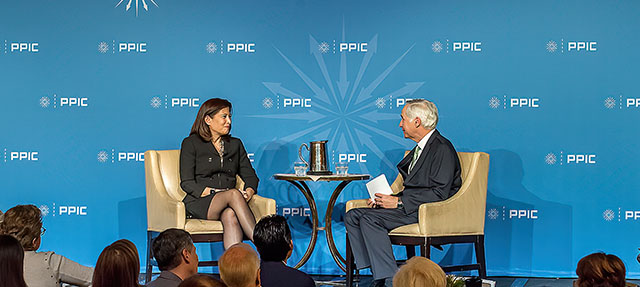Last Thursday, at a lunchtime event in Sacramento, PPIC president Mark Baldassare talked with Tani Cantil-Sakauye, California’s chief justice and the leader of the state’s judicial branch. Their conversation covered a wide range of challenges and opportunities facing the courts today. In particular, Cantil-Sakauye spoke about civic education, the collaborative courts, and the critical importance of self-evaluation in the judicial branch.
Cantil-Sakauye is known for her efforts to make the courts accessible and understandable to all Californians. She became convinced of the need to educate the public about the judicial branch after the state judiciary was hit hard by budget cuts during the Great Recession. Cantil-Sakauye recalled that state legislators responded to her pleas for adequate funding with “quizzical looks” and questions: “‘What agency are you from? . . .Which chief are you?’ . . . And I thought a civics education initiative might be in order!“
She launched an initiative called the Power of Democracy in 2012: “Judges and lawyers, the president of the California Chamber of Commerce, labor unions, and scholars come together to teach civics to K–12 and also adult students.” In her view, helping Californians understand that “the courts exist for you to press your rights” empowers them to advocate for themselves and their communities.
Asked to name her greatest accomplishments, Cantil-Sakauye pointed to collaboration, civility, and problem solving. “The California judiciary is a collaborative, problem-solving entity,” she said. Indeed, California has led the nation in collaborative courts—community-based courts that specialize in issues such as homelessness, landlord-tenant disputes, domestic violence, veterans, or behavioral health. These courts address underlying problems by connecting people to services and programs that can help get their lives on track. As Cantil-Sakauye put it, “The whole point of a collaborative court is to end recidivism.”
The chief justice is especially proud of the judiciary’s willingness to evaluate itself: “We ask ourselves how we’re doing and we’re honest when we’re not doing well.” A case in point is bail reform. Questions about the efficacy and fairness of bail prompted the chief justice to form a committee to study the issue. After looking at the evidence and hearing from a wide range of stakeholders, the committee unanimously recommended the elimination of cash bail “because it does not serve the purpose of protecting the community or ensuring a person’s return to court.”
The bail reform law signed by Jerry Brown last year is being contested—voters will decide its fate in November. But efforts to improve bail and other aspects of the judicial system will continue. As Cantil-Sakauye put it, “More and more, California courts are becoming social justice centers.”




